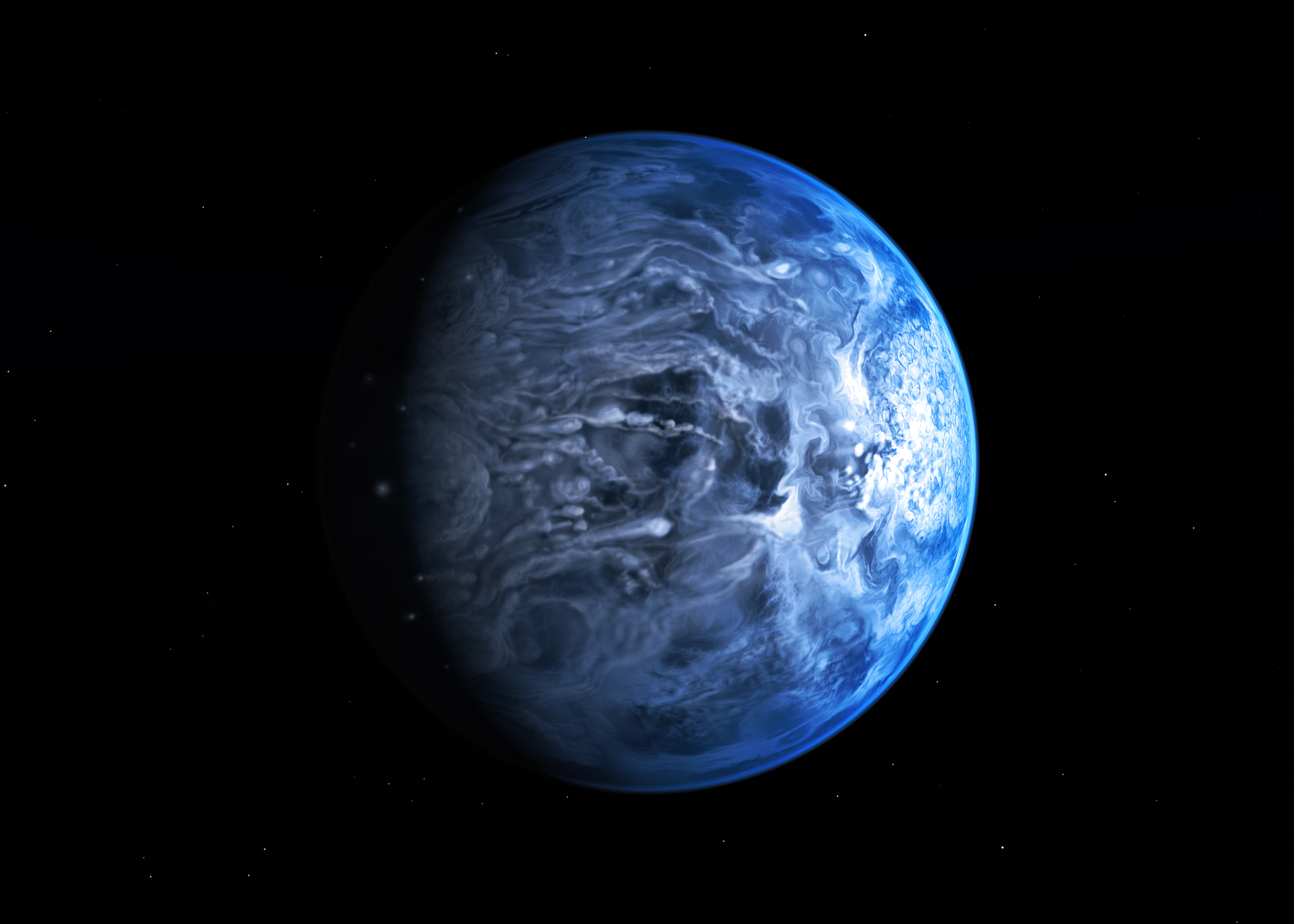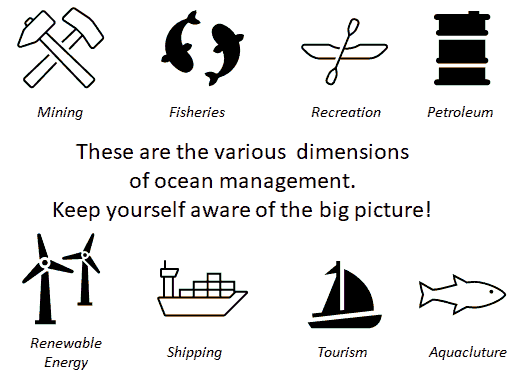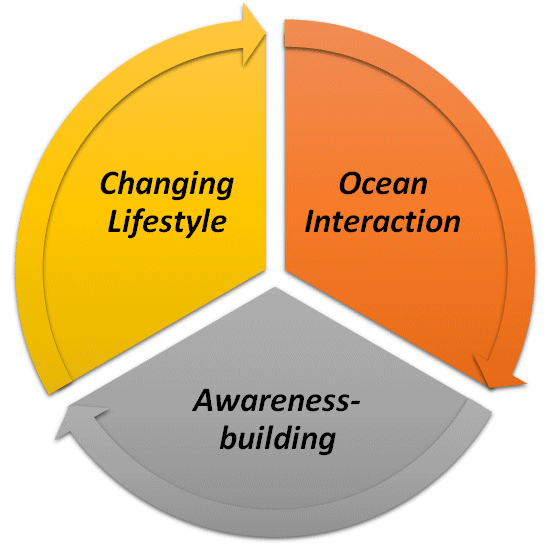Message in a Bottle:
Managing the World's Oceans
 |
Hari Srinivas |
|
Policy Analysis Series E-131. January 2022
|
 At first the oceans divided the continents ・ At first the oceans divided the continents ・
Oceans and seas have held a compelling fascination for humans from time immemorial. As generation of sea-faring explorers left the shores of their homes, oceans were a 'barrier' to be overcome in the discovery of new lands, new riches and new peoples. Very little was known and appreciated of the dynamics of oceans.
 ... then they brought them together[1] ... then they brought them together[1]
It was the photographs of earth from the first spaceships that brought about a change in attitude towards oceans. The 'blue' planet, as earth came to be called, made people realize the vastness and oneness of oceans and the related water systems like rivers, seas, etc. As scientific research and understanding grew, the interconnectedness of ocean and marine environmental systems, and everyday life became apparent, in terms of the oceans' influence on climate, biodiversity, food resources etc.
M an's relation with the ocean has often been characterized by an 'out-of-sight-out-of-mind' attitude. Almost all of earth's water is there, along with most of its living creatures, both in terms of biomass and genetic diversity. The Ocean is what makes the earth livable - it powers the climate and weather, shapes planetary chemistry, regulates temperature and is the foundation of earth's life support.
|
|
It is only in the last few hundred years that a better understanding of the oceans has begun to emerge ・especially the cyclical linkages of oceans' impact on our daily lives (food, climate, water etc.) and our impact on oceans (pollution, biodiversity, etc.) The oceans contain a vast, and largely unexplored, diversity of life, from the smallest of micro-organisms to the largest mammals on earth, blue whales.

The ocean provides food, medicine, energy and serves as a recreational resource for millions of people. Its biological wealth (estimated to be 300 to 500 million species of organisms) is concentrated along a relatively narrow strip formed by continental shelves, coastal margins and estuaries. These contain the major fishing grounds, yielding more than 80 percent of the world's fishing catch. Here, too, are the world's most productive and diverse habitats: mangroves, saltmarshes, mudflats, seagrass and seaweed beds, and coral reefs.
Globally, seafood represents one-fifth of animal protein and five percent of the total protein in the human diet. Global fish production exceeds that of cattle, sheep, poultry or eggs. It is the biggest source of wild or domestic protein in the world. But the high demand for food has left 15 of the world's 17 largest fisheries are either overfished or in trouble.
Oceans and Climate
The most significant insights emerging from recent oceanographic and scientific research has been the influence of oceans on climate. Any big weather event, such as a hurricane, typhoon, flood or drought, is generated by ocean conditions
The oceans and the atmosphere are tightly linked and together form the most dynamic component of the climate system, influencing over long and short time-scales. They play a critical role in storing heat and carbon, with ocean water constantly being moved about by powerful currents. These currents influence the climate by transporting heat. Currents involved in "deep-water formation" are particularly important for climate. An apparently small change in just one aspect of the ocean's behavior can produce major climate variations over large areas of the earth, sometimes lasting decades.
Human Fingerprints all over
Whereas in the 1950s one scientist remarked, ・.it may be rash to put any limit on the mischief of which man is capable, but it would seem that those 100 and more million cubic miles of water・s the great matrix that man can hardly sully and cannot appreciably despoil,・now the effect of human activity on the oceans is depressingly clear. Fish stocks are close to collapse, pollution has claimed the lives of millions of seabirds and untold numbers of birds, marine mammals and sea turtles become entangled or ensnared each year in plastic debris or fishing nets. Vital coastal habitats are being buried, damaged, altered or destroyed by construction and development.
In order to understand and reduce the impact of human activities on the ocean, policies and programs need to revolve around the key dimensions of the interaction between humans and oceans. They include bio-resources utilization, transportation and harbors, mineral resources exploitation, scientific research, recreation and tourism, and military activities. These dimensions are the starting points of environmental impacts on oceans.
Consider these facts - three out of five persons in the world live within 60 kilometers of an ocean; one-fourth to one-third of gross domestic products of many countries is produced in coastal areas through fishing, transportation, recreation and related industries; virtually every commercial fish species in every ocean and sea is seriously depleted and marine biological diversity is slowly being destroyed as a result of overexploitation of species, physical alteration of ecosystems, pollution, alien species from distant waters transported in ships・ballast water disrupting local food webs, global atmospheric change and other causes.
|
|
Nearly six billion of us are putting pressures on the marine environment that sustains us. The life-support functions of earth's oceans are burdened with oily ballast and other wastes dumped overboard from millions of motorized vessels and pollution flowing from land and air to the sea, along with millions of tons of hard trash - oil spills are among the most obvious forms of pollution, but attention is shifting to less visible contaminants, especially the flow of excess fertilizer and other chemicals that are applied to crops, lawns, golf courses, fields and parks.
Oceans as dumpsites
Oceans have also been polluted for decades, with many species of fish threatened with extinction, and coral reefs, once a safe haven for a variety of animal and plant life, have suffered greatly. The reefs・proximity to coastal regions make them especially susceptible to land-based sources of pollution.
Most of the wastes and contaminants produced by human activities end up in the oceans. Some are directly drained or dumped, either purposely or accidentally, in the case of oil spills. Rivers carry runoff from city streets, sewage, industrial wastes, pesticides and fertilizers from farms, and silt from land-clearing and construction projects. Some 40% of the land in the United States, including the farmland of the mid-west, drains into the Gulf of Mexico. The nitrate-rich river water has spoiled an area of the sea bed the size of New Jersey. The web of responsibility spreads very wide - nobody knows the cost of this damage, nor how much each farmer caused and what it would cost to prevent it.
Some pollutants first enter the atmosphere and later settle in the ocean. Chemical contamination and litter exist from the poles to the tropics, from beaches to ocean depths. The open ocean is relatively clean because most pollutants come from land and remain in water near coastal areas.
|
|
More than 80 percent of pollution to the marine environment comes from land-based sources, such as runoff pollution. Runoff pollution includes many small sources, like septic tanks, cars, trucks and boats, plus larger sources, such as farms, ranches and forest areas. Millions of motor vehicle engines make daily, one-drop-at-a-time "oil spills" onto roads and parking lots, which add significantly to runoff pollution. Some water pollution actually starts as air pollution, which settles into waterways and oceans. Dirt can also be a pollutant. Top soil or silt from fields or construction sites can run off into waterways, harming fish and wildlife habitats.
A Vision for the Oceans
A drastic rethinking of our relationship with oceans requires, as a first step, a vision to guide action. Such a vision [2] should stress the point that oceans and the creatures that live in it are a vital and necessary part of life on this planet. Maintaining the health of the oceans and the abundance of its fisheries, together with the wise and safe uses of all its resources, must be accepted and honored by governments so that future generations can enjoy the continuing benefit for all peoples. It is also important to holistically understand the marine environment and its living community for appropriate decision-making to protect its resources.
Concerted action involving stakeholders from the local level to the global levels is necessary to succeed - within countries people can influence ocean policies if they act together - internationally, countries can help their neighbors and accept regional policies and actions. Data and information on the ocean should be readily available - international and intergovernmental organizations should be used to generate global programs and agreements.
Because of the global nature of human activities that impact the ocean, and the fact that national 登wnership・of the oceans has always been limited and a contentious issue, several international legal instruments and conventions aimed at protecting the oceans have been adopted. Specifically these include the UN Convention on Straddling Fish Stocks and Highly Migratory Fish Stocks which deals with the difficult issue of fisheries whose targets migrate between countries・national waters and the high seas, and the UN Law of the Sea, which covers a wide array of issues, from navigation rights to fisheries and seabed mining.
Most of the conventions unfortunately suffer from improper implementation, and being global in nature, do not necessaruly reflect local needs and variations. MEAs also suffer from weak monitoring and lack of political will. The inevitable compromise between conservation and exploitation almost invariably tends to leave marine ecosystems in a position which does not provide the protection it needs.
The WWF Endangered Seas Campaign for example has begun focusing more on the market, and has been working with Unilever to establish a Marine Stewardship Council, setting up a global, industry-wide mechanism for identifying and labeling sustainably-caught fish. In India, the National Fishworkers・Forum is seeking to establish the first-ever international association of small-scale, inshore fishers, to draw global attention to the threat to their livelihood from giant offshore fishing fleets and the destructive environmental and social effects of shrimp aquaculture.
Another example: Globally, the opposition to shrimp aquaculture has become a real grass-roots movement, the thrust of which is trying to persuade consumers that 殿ll you can eat・deals are not good deals from the point of view of the environment or inshore fishers in India, Thailand and Ecuador.
Moving Oceans: Community Participation in Ocean Management
 No global agreement on oceans can be fruitful without adequate local community commitment. Oceans and coastal areas are distinctive resource systems that require special management and planning approaches. Such approaches need to adopt a systematic, incremental approach in developing and implementing ocean management projects and programs. Awareness building and education at the local level remain the cornerstones of any approach that integrates environmental, economic, and social information from the very beginning of the process. No global agreement on oceans can be fruitful without adequate local community commitment. Oceans and coastal areas are distinctive resource systems that require special management and planning approaches. Such approaches need to adopt a systematic, incremental approach in developing and implementing ocean management projects and programs. Awareness building and education at the local level remain the cornerstones of any approach that integrates environmental, economic, and social information from the very beginning of the process.
Preserving and managing resources (seafood, aesthetic, recreation, marine, mineral and other resources) of the oceans involves a multiplicity of actors and actions at various levels. But some of the most effective and sustainable actions come as a groundswell of participation from coastal communities themselves, influencing the use of ocean resources in a variety of ways.
Depending on the local conditions such as culture, income levels, settlement patterns, etc. the degree and range of community participation activities varies. On the whole, three broad categories of community participation issues with respect to ocean management can be developed - (1) changing lifestyles, (2) interaction with oceans and coastal regions, and (3) awareness-building and education.
Changing Lifestyle
We have to focus on reducing waste generation and disposal from households and businesses/industries that may drain into rivers and oceans. Changing lifestyles also requires
minimizing air pollution and CO2 emissions that could increase acid rain and influence various climatic aspects. Prudent consumption of seafood that does not affect or strain existing fish stocks or endangered marine species will be necessary, as will minimizing the use of household pollutants, including herbicides, pesticides etc. that may end up in coastal watersheds.
Ocean Interaction
Enlightened beach behavior can lead to reduction of wastes, and will not disturb sea habitats and eco-systems. Gentle interaction with marine life forms that is treated with respect and understanding, as well as reducing the environmental impact of boating, fishing, diving, and other coastal recreational activities will go a long way in reducing human impact on oceans.
Awareness-building and Education
Educating, and being aware, of the direct and indirect effects of individual actions on the oceans is indeed a starting point for any comprehensive ocean management program. Participation in activities relating to coasts and oceans; volunteering for clean-ups etc. has to be balanced with the enforcement and compliance of laws and legislation related to coasts and oceans.
Thus, while appropriate policy, program and fiscal actions will go a long way in managing our oceans, it is the active and concerted involvement of local communities at all stages of implementation that will eventually lead to long-lasting positive results.
Footnotes
[1] "At first the oceans divided the continents, then they brought them together" was the theme of the EXPO98 held in Portugal in 1998, the International Year of the Oceans.
[2] Inspired by "A Personal Charter for the Oceans" proposed by the International Oceanographic Commission
|